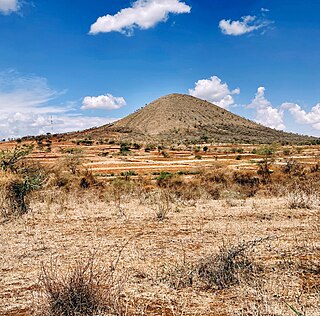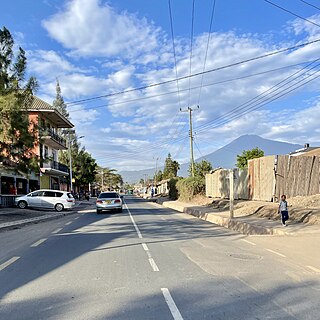
'Monduli District is one of seven districts of the Arusha Region of Tanzania. It is bordered to the north by Longido District, to the east by Arusha Rural District, to the south by the Manyara Region and to the west by Ngorongoro District and Karatu District. The District covers an area of 6,993 km2 (2,700 sq mi). The town of Monduli is the administrative seat of the district. According to the 2002 Tanzania National Census, the population of the Monduli District was 185,237. By 2012, the population of the district was 158,929. By 2022, the population had grown to 227,585.

Akheri is an administrative ward in the Meru District of the Arusha Region of Tanzania with an area of 16.65 km². Akheri ward is home to Lake Duluti. The largest settlement in the ward is the town of Tengeru. The ward is also home to Polish refugees WWII Cemetery. According to the 2002 census, the ward has a total population of 12,243.
Leguruki is an administrative ward in the Meru District of the Arusha Region of Tanzania. The ward is home to ober 60 small lakes and is the lake ward of Meru district and also home to the eastern section of Arusha National Park. The ward is bordered to the east by Siha Distric of Kilimanjaro Region. According to the 2002 census, the ward has a total population of 15,678.
Makiba is an administrative ward in the Meru District of the Arusha Region of Tanzania. The ward is bordered by Mererani ward located in Manyara Region which is the only source of Tanzanite on earth. Makiba is a transit ward to Merenani from Arusha Region, the largest importer of the gemstone. According to the 2002 census, the ward has a total population of 12,056.

Mateves is a Tanzanian administrative ward located in Arusha Rural District of the Arusha Region. It is one of 21 administrative wards in the district. Mateves means places where the fever tree grows in the Maasai language. Mateves ward is bordered by Musa ward to the northwest, Oltrumet ward to the far northeast, a tip of the Olorieni ward to the northeast as well. Olasiti ward borders Mateves to the north east and Terrat to the south east. To the south of Mateves is Oljoro ward and the southwest of Mateves is the Moita Ward and lastly, towards the west is Kisongo ward. The small town of Ngorbob is the seat of the ward. The ward is home to the Mungu Crater and Loljoro Hill at 1,585 meters. The ward covers an area of 104.4 km2 (40.3 sq mi), and has an elevation of 1,328 m (4,357 ft). According to the 2012 census, the ward had a total population of 15,632
Moivo is an administrative ward in the Arumeru district of the Arusha Region of Tanzania. According to the 2002 census, the ward has a total population of 20,562. The ward is the second most populous ward in the district after Sokon II.

Moshono is an administrative ward located in Arusha District, Arusha Region of Tanzania. It is one of 19 urban administrative wards in the municipality. Moshono ward is bordered by four wards to the north namely; Bangata, Baraa and Nkoanrua. Moshono is bordered to the west by Olorein, Themi and Engutoto wards. The ward of Mlangarini borders Moshono to the east. Moshono ward is the third largest ward in Arusha Urban District thus its mostly a rural ward with many farming communities and large schools. The ward covers an area of 24.59 km2 (9.49 sq mi), and has an elevation of 1,348 m (4,423 ft). According to the 2012 census, the ward had a total population of 20,698
Musa is an administrative ward in the Arumeru district of the Arusha Region of Tanzania. The district and ward were dissolved in 2007 becoming parts of the Arusha and Meru districts.
Mwandeti is an administrative ward in the Arusha Rural District of the Arusha Region of Tanzania. According to the 2002 census, the ward has a total population of 14,643.
Nduruma, is a administrative ward in Arusha Rural District in the east Arusha Region of Tanzania. It is bordered to the north by Mlangarini, to the south by Bwawani, and to the east by Kikwe ward of the Meru District. The ward covers an area of 62.72 square kilometres (24.22 sq mi) with an average elevation of 1,041 metres (3,415 ft).
Ngarenanyuki is an administrative ward in the Meru District of the Arusha Region of Tanzania. The ward is the largest ward in Meru district. It is located in far north side of the distric. According to the 2002 census, the ward has a total population of 16,988.
Nkoaranga is an administrative ward in the Meru District of the Arusha Region of Tanzania. the ward is home to part of the Arusha National Park, Nkoaranga Hospital and the Ngaresero Lodge. According to the 2002 census, the ward has a total population of 13,338.
Nkoarisambu is an administrative ward in the Meru District of the Arusha Region of Tanzania. The ward is the least populous ward in the distric. According to the 2002 census, the ward has a total population of 6,497.
Oljoro is an administrative ward in the Arusha Rural District of the Arusha Region of Tanzania. The ward is home to Mungu Crater which is 1,030 meters deep. According to the 2002 census, the ward has a total population of 7,896

Oltroto or also spelt as Oltoroto is a Tanzanian administrative ward located in Arusha Rural District of the Arusha Region. Oltoroto means "a place to collect chalk" in Maasai language. The ward is bordered by Ilkiding'a to the north, Sokon II to the east, Moivo to the south and finally Olorieni and Kiranyi wards to the west. The ward is home to plateau mountain called Oldonyo Sapuk and on the east of the ward is Kivesi Hill at 1,897 meters tall. The ward covers an area of 11.85 km2 (4.58 sq mi), and has an average elevation of 1,699 m (5,574 ft). According to the 2012 census, the ward had a total population of 15,451

Elerai is an administrative ward in Arusha District, Arusha Region of Tanzania. It is one of 19 urban administrative wards in the municipality. The ward is bordered by Olasiti ward to the west, Kiranyi ward to the north, Ngarenaro ward to the east, Sombetini to the south and, a tiny portion of Unga L.T.D ward to the southeast. The ward covers an area of 3.746 km2 and ranks number eleven in the area in Arusha city. The ward is home to the national National College of Tourism, the African Court and Tanzania National Parks Authority (TANAPA)'s national headquarters, also the Arusha Modern school. The school's famous alumna is Tanzanian recording artist, Vanessa Mdee, who received secondary education there. According to the 2012 census, the ward had a total population of 40,749.

Kati is an administrative ward in the Arusha City Council of the Arusha Region of Tanzania. Kati means "center" in Swahili language. Kati is one of 25 urban administrative wards in the City. The ward is bordered by Levolosi ward to the west, Kaloleni ward to the north, Sekei ward to the northeast, Themi ward to the southeast, Daraja Mbili to the south and, Unga L.T.D ward to the southwest. The ward covers an area of 0.580 km2 (0.224 sq mi) and is the smallest ward in Arusha city.

Sombetini is one of the 19 administrative wards of the Arusha City Council located in the Arusha Region of Tanzania. The ward is bordered by Elerai ward to the north, Unga Limited and Sokon I wards to the east. The wards of Olasiti and Terrat are located in to west and south respectively. The ward covers an area of 5.173 km2 (1.997 sq mi), According to the 2012 census, the ward had a total population of 48,268.

Themi is an administrative ward in the Arusha District of the Arusha Region of Tanzania. It is home to Themi Hill which is 1,457 meters tall. The ward also gets its name from the hill and river which runs on its western border. Themi ward is bordered by Kati and Sekei wards to the north. Kimandolu, Moshono, Olorien wards border the ward to the east. To the south is Engutoto and Lemara wards. Lastly, to the west Themi ward is bordered by Daraja Mbili ward. The ward covers an area of 6.200 km2 (2.394 sq mi), and has an average elevation of 1,325 m (4,347 ft). According to the 2012 census, the ward had a total population of 9,458

Arusha District or Arusha District Council is one of the seven districts of the Arusha Region of Tanzania. The district is bordered to the north by Longido District, to the east by Meru District, to the south by Kilimanjaro Region, and to the west by Monduli District. the district surrounds Arusha City on all three sides. The district covers an area of 1,547.6 km2 (597.5 sq mi). The district is comparable in size to the land area of Guadeloupe. The district capital is located in Sokon II. According to the 2022 Tanzania National Census, the population of Arusha District was 449,518.











